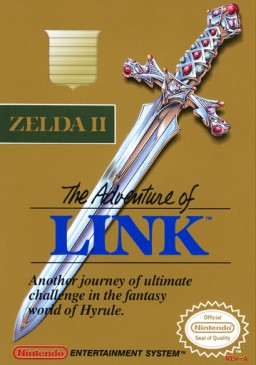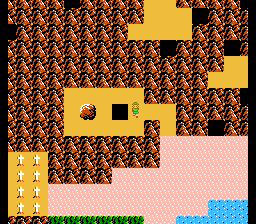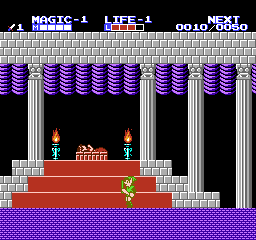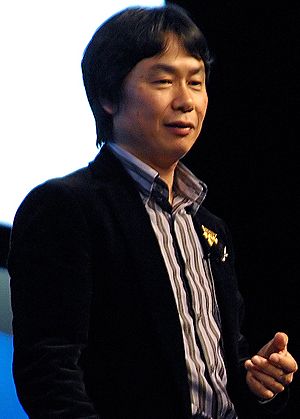Zelda II: The Adventure of Link facts for kids
Quick facts for kids Zelda II: The Adventure of Link |
|
|---|---|

North American box art
|
|
| Developer(s) | Nintendo R&D4 |
| Publisher(s) | Nintendo |
| Director(s) | Tadashi Sugiyama Yasuhisa Yamamura |
| Producer(s) | Shigeru Miyamoto |
| Designer(s) | Kazunobu Shimizu |
| Programmer(s) |
|
| Writer(s) | Takashi Tezuka |
| Composer(s) | Akito Nakatsuka |
| Series | The Legend of Zelda |
| Platform(s) | Famicom Disk System Nintendo Entertainment System GameCube Game Boy Advance |
| Release date(s) |
|
| Genre(s) | Action role-playing, platform |
| Mode(s) | Single-player |
Zelda II: The Adventure of Link is an exciting action role-playing game made by Nintendo. It is the second game in the famous The Legend of Zelda series. It first came out in Japan on January 14, 1987. Later, it was released in North America and Europe in late 1988 for the Nintendo Entertainment System (NES).
This game is a direct follow-up to the first The Legend of Zelda adventure. You play as Link again, and your mission is to save Princess Zelda. She has fallen into a deep sleeping spell. This game was different from the first Zelda because it used more side-scrolling views and role-playing elements.
Zelda II was very popular and successful. It added new things like Link's "magic meter" and the character Dark Link. These ideas became common in later Zelda games. However, some role-playing parts, like gaining experience points and having limited lives, were not used in main Zelda games after this one. The next game in the series was A Link to the Past in 1991.
Contents
Gameplay Basics
Zelda II: The Adventure of Link is an action role-playing game that plays differently from other Zelda games. It mixes two main views: a top-down world map and side-scrolling areas. The first Zelda game only used a top-down view.
The side-scrolling parts and the way Link gains experience are similar to games like Castlevania II: Simon's Quest. This game also has a special combat system, a system where you continue near where you died, and experience points. You can also use magic spells and talk to more people in towns.
Leveling Up Link
In Zelda II, Link gets experience points by beating enemies. These points help him make his Attack, Magic, and Life stronger. Each of these can go up to eight levels.
- Attack makes Link's sword hits more powerful.
- Magic makes spells cost less magic to use.
- Life helps Link take less damage from enemies.
When you get enough points, you can choose which skill to improve. Once a skill reaches its highest level, getting more points for it gives Link an extra life! Link starts with four Heart Containers and four Magic Containers. He can find four more of each to get more life and magic points.
Exploring the World
The Adventure of Link uses two different views for exploring. The overworld map is seen from a top-down view. This map helps you navigate to different places. As you walk on the map, enemies might randomly appear. Small blobs mean easy enemies, while larger figures mean tougher ones. Sometimes, a Fairy appears to heal Link.
When Link enters towns, buildings, or caves, or when he meets wandering monsters, the game switches to a side-scrolling view. Most of the action and danger happen in these side-scrolling areas.
Combat System
The fighting in The Adventure of Link is more complex than in the first game. Link uses a sword and shield. He can stand or crouch to attack and defend. For example, some enemies like the Iron Knuckle change their attack height, so Link must change his stance to hit them. Link can also jump, which is useful for attacking flying enemies or dodging attacks. Later, he learns special moves like stabbing downwards or upwards while jumping.
Magic and Special Items
Instead of many active items, The Adventure of Link has eight magic spells. Link learns these spells from wise men in different towns. Often, Link must complete small side-quests to earn a new spell. Some spells and items are needed to move forward in the game. For example, the "Life" spell is very important for healing Link during battles, as healing Fairies are rare.
Saving Your Game
Like the first Zelda game, The Adventure of Link lets you save up to three different games. If you finish the game, you can start a new game with your saved file. This lets you keep Link's experience levels, special moves, and magic spells. However, you will need to find special items, Heart and Magic containers, and extra lives again.
Story of the Adventure
The story of Zelda II happens several years after the first Legend of Zelda. Link is now 16 years old. He notices a strange mark on his left hand, which looks exactly like the crest of Hyrule. He goes to see Impa, a wise old woman. Impa takes him to the North Castle, where a door has been magically sealed for a very long time.
Impa places Link's hand on the door, and it opens! Inside, they find a sleeping maiden. Impa tells Link that this is Zelda, a princess from long ago. She is not the same Zelda from the first game. This old Zelda's brother tried to make her tell him secrets about the Triforce. When she refused, his wizard friend tried to attack her with a spell. The spell put Zelda into a deep sleep, but it also killed the wizard. The prince felt very sad and could not undo the spell. He put his sister in the castle tower, hoping she would wake up one day. He then ordered that all princesses born into the royal family from then on would be named Zelda, to remember this sad event.
Impa explains that the mark on Link's hand means he is the chosen hero to wake Zelda. She gives Link a chest with six crystals and old writings. Link finds he can read the writings, even though he's never seen the language before. The writings say that the crystals must be placed into statues in six palaces across Hyrule. This will open the way to the Great Palace, which holds the Triforce of Courage. Only the power of all three Triforces together can wake Zelda.
Link takes the crystals and begins his quest. Meanwhile, Ganon's followers are trying to kill Link. They believe that if they sprinkle Link's blood on Ganon's ashes, Ganon will come back to life.
Link successfully places the crystals in all six palaces and enters the Great Palace. Deep inside, he battles a flying creature called Thunderbird. After that, Link faces his own shadow, Dark Link. Link wins and claims the Triforce of Courage. He returns to Zelda, and the Triforce unites, waking her up!
Game Creation and Releases
Shigeru Miyamoto, who helped create the first Zelda game, wanted Zelda II: The Adventure of Link to be very different. A new team was put together to make the game. Miyamoto was the producer, and Takashi Tezuka wrote the story. The game had two directors, Tadashi Sugiyama and Yasuhisa Yamamura. The music composer was Akito Nakatsuka.
The Adventure of Link first came out in Japan for the Family Computer Disk System (FDS). Later, it was released around the world. There were some small differences between the FDS version and the English cartridge version. For example, the dungeons in the FDS version were all gray or green, but in the English version, each dungeon had a unique color. Also, the "Game Over" screen was different.
The game was re-released several times over the years. In 2003, it was on The Legend of Zelda: Collector's Edition for the GameCube. In 2004, it was part of the Classic NES Series for Game Boy Advance. Later, it came to the Wii's Virtual Console in 2007, the Nintendo 3DS's Virtual Console in 2011, and the Wii U's Virtual Console in 2013. It was also one of the 30 games included in the NES Classic Edition in 2016.
Game's Impact
Zelda II introduced many ideas that became important in later Zelda games. For example, more non-player characters (NPCs) had bigger roles in Link's quests. Zelda II was one of the first games where NPCs seemed to have their own lives and goals. The use of a magic meter and spells also continued in other Zelda games.
The Triforce of Courage was first shown in The Adventure of Link. It became very important in future Zelda games and is strongly linked to Link. Dark Link, a shadow version of Link, appeared in this game. Similar shadow versions of Link have shown up in games like Ocarina of Time and Four Swords Adventures.
The Adventure of Link was one of the first games to mix role-playing video game and platforming elements in a big way. Many Japanese games after it used a similar style. Games like Cadash (1989) looked a lot like Zelda II, with side-scrolling levels and RPG features like stats, weapons, and magic.
Five of the wise people (sages) in Ocarina of Time have the same names as towns from The Adventure of Link. These include Rauru, Ruto, Saria, Nabooru, and Darunia. This shows how Zelda II influenced later games.
The Adventure of Link is the only main Zelda game that doesn't have "The Legend of Zelda" in its title. It's also the only Zelda game to feature extra lives (1-up dolls). The next game, A Link to the Past, went back to the top-down style of the first game.
Some later Zelda games, like Link's Awakening, still had a few side-scrolling areas, mostly in tunnels and caves. The series moved to 3D graphics with Ocarina of Time in 1998.
Music from Zelda II has also appeared in other Nintendo games. A new version of the "Temple" music is in Super Smash Bros. Melee and Super Smash Bros. Brawl. This music was updated again for the Nintendo 3DS game A Link Between Worlds. The StreetPass battle mode in A Link Between Worlds was even inspired by the final boss fight in Zelda II, where you fight a shadow version of Link.
Zelda II inspired many other NES games like Faxanadu and The Battle of Olympus. More recently, games like Adventure Time: Hey Ice King! Why'd You Steal Our Garbage?!! and Elliot Quest have taken direct inspiration from Zelda II. These games often have side-scrolling combat areas connected by a larger top-down world map, creating a small genre of "Zelda II-like" games.
See also
 In Spanish: Zelda II: The Adventure of Link para niños
In Spanish: Zelda II: The Adventure of Link para niños




